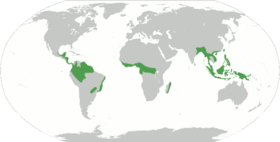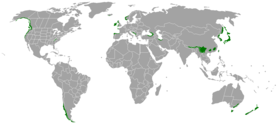Rainforest
2008/9 Schools Wikipedia Selection. Related subjects: Environment

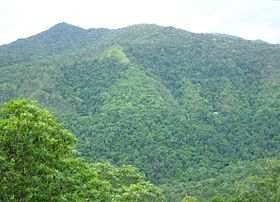
Rainforests are forests characterized by high rainfall, with definitions setting minimum normal annual rainfall between 1750–2000 mm (68-78 inches).
Rainforests are home to two-thirds of all the living animal and plant species on Earth. It has been estimated that many hundreds of millions of species of plants, insects and microorganisms are still undiscovered. Tropical rainforests have been called the "jewels of the Earth," and the "world's largest pharmacy," because of the large number of natural medicines discovered there.
The undergrowth in a rainforest is restricted in many areas by the lack of sunlight at ground level. This makes it possible to walk through the forest. If the leaf canopy is destroyed or thinned, the ground beneath is soon colonized by a dense, tangled growth of vines, shrubs and small trees called a jungle. The two types of rainforest are:
- Tropical rainforests are rainforests in the tropics, found near the Equator (between the Tropic of Cancer and Tropic of Capricorn) and present in southeast Asia (Myanmar to Indonesia and Papua New Guinea, northern and eastern Australia), sub-Saharan Africa from Cameroon to the Congo, (Congo Rainforest), South America (the Amazon Rainforest) Central America ( Bosawás, southern Yucatán Peninsula- El Peten-Belize- Calakmul), and on many of the Pacific Islands(such as Hawaii). Tropical rainforests have been called the "Earth's lungs," although it is now known that rainforests contribute little net oxygen additions to the atmosphere through photosynthesis.
- Temperate rainforests are rainforest in temperate regions. They can be found in North America (in the Pacific Northwest, the British Columbia Coast, and in the inland rainforest of the Rocky Mountain Trench east of Prince George), in Europe (in coastal areas of Ireland, Scotland and southern Norway, parts of the western Balkans along the Adriatic coast, as well as in the North West of Spain and coastal areas of the eastern Black Sea, including Georgia and coastal Turkey), and in East Asia (in southern China, Taiwan, much of Japan and Korea, and on Sakhalin Island and the adjacent Russian Far East coast), and also Australia and New Zealand.
Soils
Despite the growth of vegetation in a rainforest, soil quality is often quite poor. Rapid bacterial decay prevents the accumulation of humus. The concentration of iron and aluminium oxides by the laterization process gives the oxisols a bright red colour and sometimes produces minable deposits such as bauxite). On younger substrates, especially of volcanic origin, tropical soils may be quite fertile.
Effect on global climate
A natural rainforest emits and absorbs vast quantities of carbon dioxide. On a global scale, long-term fluxes are approximately in balance, so that an undisturbed rainforest would have a small net impact on atmospheric carbon dioxide levels, though they may have other climatic effects (on cloud formation, for example, by recycling water vapour). No rainforest today can be considered to be undisturbed. Human induced deforestation plays a significant role in causing rainforests to release carbon dioxide, as do natural processes such as drought that result in tree death. Some climate models run with interactive vegetation predict a large loss of Amazonian rainforest around 2050 due to drought, leading to forest dieback and the subsequent feedback of releasing more carbon dioxide.
Rainforest layers
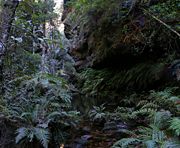
The rainforest is divided into four different parts, each with different plants and animals, adapted for life in that particular area:
- The emergent layer contains a small number of very large trees which grow above the general canopy, reaching heights of 45-55 m, although on occasion a few species will grow to 70-80 m tall. They need to be able to withstand the hot temperatures and strong winds. Eagles, butterflies, bats and certain monkeys inhabit this layer.
- The canopy layer contains the majority of the largest trees, typically 30-45 m tall. The densest areas of biodiversity are found in the forest canopy, a more or less continuous cover of foliage formed by adjacent treetops. The canopy, by some estimates, is home to 50 percent of all plant species, suggesting that perhaps half of all life on Earth could be found there. The fauna is similar to that found in the emergent layer, but more diverse. A quarter of all insect species are believed to exist in the rainforest canopy. Scientists have long suspected the richness of the canopy as a habitat, but have only recently developed practical methods of exploring it. As long ago as 1917, naturalist William Beebe declared that "another continent of life remains to be discovered, not upon the Earth, but one to two hundred feet above it, extending over thousands of square miles." True exploration of this habitat only began in the 1980s, when scientists developed methods to reach the canopy, such as firing ropes into the trees using crossbows. Exploration of the canopy is still in its infancy, but other methods include the use of balloons and airships to float above the highest branches and the building of cranes and walkways planted on the forest floor. The science of accessing tropical forest canopy using airships, or similar aerial platforms, is called dendronautics.
- The understory layer lies between the canopy and the forest floor. The understory (or understorey) is home to a number of birds, snakes, and lizards, as well as predators such as jaguars, boa constrictors, and leopards. The leaves are much larger at this level. Insect life is also abundant. Many seedlings that will grow to the canopy level are present in the understory. Only about 5 percent of the sunlight shining on the rainforest reaches the understory. This layer can also be called a shrub layer, although the shrub layer may also be considered a separate layer.
- The forest floor layer receives only 2 percent of sunlight. Only plants adapted to low light can grow in this region. Away from riverbanks, swamps, and clearings where dense undergrowth is found, the forest floor is relatively clear of vegetation because of the low sunlight penetration. It also contains decaying plant and animal matter, which disappears quickly due to the warm, humid conditions promoting rapid decay. Many forms of fungi grow here which help decay the animal and plant waste.
Flora and Fauna
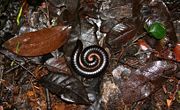
More than half of the world's species of plants and animals are found in the rainforest. Rainforests support a very broad array of fauna including mammals, reptiles, birds and invertebrates. Mammals may include primates, felids and other families. Reptiles include snakes, turtles, chameleons and other families while birds include such families as vangidae and Cuculidae. Dozens of families of invertebrates are found in rainforests. Fungi are also very common in rainforest areas as they can feed on the decomposing remains of plant and animal life. As a result of all the decomposing matter on the forest floor, rainforests develop high levels of organic matter in the soil, making it very nutritious for plant and animal life. This humus is a major factor in allowing rainforests to be highly active ecosystems, with rainforests home to more than two-thirds of the Earth's species. This amounts to over 5 million species of plants and animals.
Human uses
Tropical rainforests provide timber as well as animal products such as meat and hides. Rainforests also have value as tourism destinations and for the ecosystem services provided. Many foods originally came from tropical forests, and are still mostly grown on plantations in regions that were formerly primary forest. Tropical rainforests are also the source of medicinal drug components.
Rainforests cover only six percent of the Earth, however, twenty-five percent of all drugs are derived from rainforest ingredients.
More than 1,430 varieties of tropical plants are thought to be potential cures for cancer. The National Cancer Institute claims that 70 percent of the plants identified as having anti-cancer properties are found exclusively in rainforests. The rainforest has shown to hold many other types of medicines as well, from everyday pain killers like aspirin to important cardiac drugs. In fact, plant derived medicines are commonly used for fever, fungal infections, burns, gastrointestinal problems, pain, respiratory problems, and wound treatment.
Deforestation
Tropical and temperate rain forests have been subjected to heavy logging and agricultural clearance throughout the 20th century, and the area covered by rainforests around the world is rapidly shrinking. Biologists have estimated that large numbers of species are being driven to extinction (possibly more than 50,000 a year) due to the removal of habitat with destruction of the rainforests. Protection and regeneration of the rainforests is a key goal of many environmental charities and organizations. (It is doubtful that this rate will be sustained as the relative cost of logging rises with dwindling resources.)
Another factor causing the loss of rainforest is expanding urban areas. Littoral Rainforest growing along coastal areas of eastern Australia is now rare due to ribbon development to accommodate the demand for seachange lifestyles.
About half of the mature tropical rainforests, between 750 to 800 million hectares of the original 1.5 to 1.6 billion hectares that once graced the planet have already fallen. The devastation is already acute in South East Asia, the second of the world's great biodiversity hot spots. Most of what remains is in the Amazon basin, where the Amazon rainforest covered more than 600 million hectares, an area nearly two thirds the size of the United States. The forests are being destroyed at an ever-quickening pace. Unless significant measures are taken on a world-wide basis to preserve them, by 2030 there will only be 10% remaining with another 10% in a degraded condition. 80% will have been lost and with them the natural diversity they contain will become extinct.
Many tropical countries, including Indonesia, Thailand, Malaysia, Bangladesh, China, Sri Lanka, Laos, Nigeria, Liberia, Guinea, Ghana and the Cote d'lvoire have already lost large areas of their rainforest. Eighty percent of the forests of the Philippine archipelago have already been cut down. In 1960 Central America still had four fifths of its original forest; now it is left with only two fifths of it. Half of the Brazilian state of Rondonia's 24.3 million hectares have been destroyed or severely degraded in recent years. Several countries, notably the Philippines, Thailand and India have declared their deforestation a national emergency.
